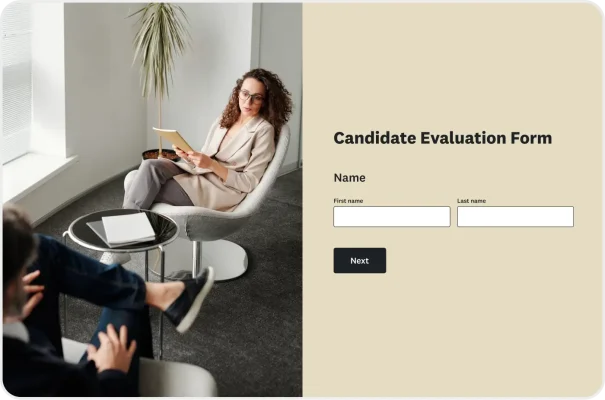Candidate Evaluation Form Template
Using a candidate evaluation form can make your hiring process fairer and faster. Learn why and use our free template.
Hiring is something that every organization does—but how many do it well? Effective hiring is compassionate, consistent, holistic, and unbiased. That’s a tall order for any business.
Candidate evaluation forms—also known as candidate scorecards or candidate assessment forms—provide a way to standardize the hiring process. Many companies use candidate assessment forms to minimize bias and ensure consistency across interviewers.
In this article, learn why candidate evaluation forms are so valuable and how you can incorporate them into your hiring process.
What is a candidate evaluation form?

A candidate evaluation form is a standardized tool that hiring managers can use to assess job candidates. Using an interview evaluation form enables teams to standardize the assessment of candidates. It also helps interviewers provide more objective feedback.
Incorporating candidate scorecards into the hiring process is good for your brand. When candidates have a positive interview experience, they speak highly of your business.
The typical candidate evaluation form includes a few key dimensions along which candidates are scored:
- Skills and qualifications
- Relevant work experience
- Cultural fit within the organization
- Behavioral and situational responses to interview questions
Why candidate evaluation is essential
Candidate evaluation is a central part of any transparent and effective hiring process. Here’s why.
- Streamlines decision-making. A systematic candidate evaluation provides actionable insights into a candidate’s fit. Interviewers can clearly indicate why a candidate is or is not a good fit for a role. This makes it easier for hiring teams to come to a decision—or tweak job descriptions if necessary.
- Ensures a fair assessment. Structured candidate evaluation forms level the playing field for candidates. By providing a standardized method for assessing candidates, these forms cut down on discrepancies between interviewers. Unstructured hiring processes are generally less fair and organized.
- Reduces interviewer bias. Providing a consistent framework significantly reduces the chance that bias will impact the hiring process. A candidate scorecard limits subjectivity.
- Improves hiring outcomes. Implementing a systematic candidate evaluation process enables companies to improve their hiring outcomes by 24 percent, according to research from LinkedIn.
- Provides a better candidate experience. Using a scorecard or form makes the hiring process smoother and easier for the candidate. Giving a candidate a positive experience is good for your brand, regardless of whether you end up hiring them.
6 actionable tips for candidate evaluation
Evaluating a candidate is a high-stakes task. But it doesn’t have to be difficult. Here are six tips to empower your hiring teams to streamline the hiring process.
1. Optimize when to send the candidate evaluation form
To use candidate evaluation forms effectively, be intentional about when you send them to interviewers. Typically, it’s a good idea to send them right after interviews. That way, interviewers can jot down their impressions while the interview is fresh in their mind. By sending out the form right after an interview, you can ensure interviewers will remember specific examples they might otherwise forget.
Consider sending out a reminder if interviewers don’t complete the survey within a few hours of the interview. Even a short, gentle nudge can help encourage interviewers to jot down their impressions while they’re still vivid and easily accessible.
2. Ensure interviewers complete the form in a timely manner
Strongly encourage interviewers to complete the form within 24 hours of the interview. Waiting too long can distort an interviewer’s perception, leading to cognitive bias that compromises the hiring process. The longer the gap between the interview and the evaluation, the more biases will enter the picture. Those biases can be positive or negative: some interviewers might develop a more rosy outlook on a candidate over time, while some might focus more on what they didn’t like about the candidate’s responses.
To streamline the process, give your interviewers a deadline for completing the survey. Interviewers are more likely to complete surveys—and do so on time—when presented with a firm deadline.
3. Ensure unbiased evaluations
All interviewers bring unconscious bias to the hiring process. Even well-intentioned interviewers can inadvertently misjudge a candidate because of their perceptions or experiences.
When evaluating candidates, avoiding bias should be a top priority. While we can never eliminate bias, however, we can recognize it-—and that’s half the battle. Train interviewers on how to recognize their unconscious bias. Encourage them to acknowledge their positionality relative to the candidate, whether that’s gender, race, age, or background. Invite them to think about how that might impact their judgement.
Get multiple interviewers involved in the process to get a holistic take on the candidate’s fit. A structured form can enable you to standardize the process, leading to fairer hiring outcomes. In general, structured forms lead to a more level playing field for candidates. They ensure interviewers focus on objective criteria rather than subjective impressions.
4. Score candidates effectively
An effective scoring system is clear and simple. Many teams use a 5-point scale. Many hiring teams use a 5-point scale that enables interviewees to rate candidates on a range of criteria. For example:
5 - Exceptional
4 - Above Average
3 - Average
2 - Satisfactory
1 - Unsatisfactory
Design the scoring criteria to reflect the core competencies of the role. For example, if you’re hiring a marketing manager, you might score candidates based on their communication skills, creativity, and experience managing integrated marketing campaigns. Each criteria should be clearly defined. This allows interviewers to score candidates accurately and with minimal bias.
5. Align scores with company priorities
Make sure the evaluation metrics align with your organization’s goals and the job requirements. For example, if you’re hiring for a leadership role on an engineering team, then project management should be weighted more than technical expertise. If you’re hiring a customer service representative, you should score them on communication, empathy, and problem-solving skills.
Aligning evaluation criteria with your company’s priorities ensures the hiring process reflects what you need from a candidate. It also helps eliminate bias and sets your new hire up for success.
6. Use comments to support scores
Supplement quantitative scores with qualitative data. Detailed feedback allows hiring managers to understand how the interviewer arrived at the score. Hiring managers can then tweak the interview questions or the job description as necessary.
Constructive feedback can help resolve disagreements between hiring team members. For instance, if one interviewer gave the candidate the highest score and another gave the lowest, feedback can clarify where each of them was coming from.
Evaluate candidates effectively with SurveyMonkey
Candidate evaluation forms are a game-changing tool in the arsenal of any HR team. Whether you’re looking to streamline your hiring process or reduce bias, a candidate evaluation form can enable you to take your hiring process to the next level.
Empower your hiring team to provide clear feedback, foster consistency, and hire top talent. Check out these free templates to kick-start your hiring process today!
Explore related templates
Explore which features support this survey template
We have so many powerful features to help you launch surveys quickly, but here are our most popular ones for new users.
Customizable survey experiences
Out-of-the-box themes, accessible color palettes, custom fonts, branding, and more.
Many ways to send your surveys
Collect survey responses via email, website, SMS, social media, QR codes, offline, and more.
Survey analysis, no training required
Automatic results summaries, filters, custom dashboards, crosstab reports, text analysis, & more.
Additional resources to help you launch successful survey projects

Success Stories
Read about our customers, explore webinars, and get guides on collecting feedback in your industry.

Blog
Get tips on how to create better surveys, hear the latest product news, or check out our research.

Help Center
Access tutorials on how features work, learn more about billing, and contact Customer Support.
Discover more resources

Attract, engage, and retain top talent with data-driven insights
Create powerful HR surveys with SurveyMonkey to gather feedback, boost engagement, and improve workplace culture. Streamline HR processes with customizable templates.

Why are surveys important in research?
Surveys are important in research because they offer a flexible and dependable method of gathering crucial data. Learn more today.

Job application surveys
Survey job applicants online to get a good understanding of your recruitment process strengths and weaknesses. Free templates and survey advice, sign up today!

HR Survey Questions: 80 Examples & Best Practices
Discover 80 HR survey questions, best practices, and tips for success to improve employee engagement.




